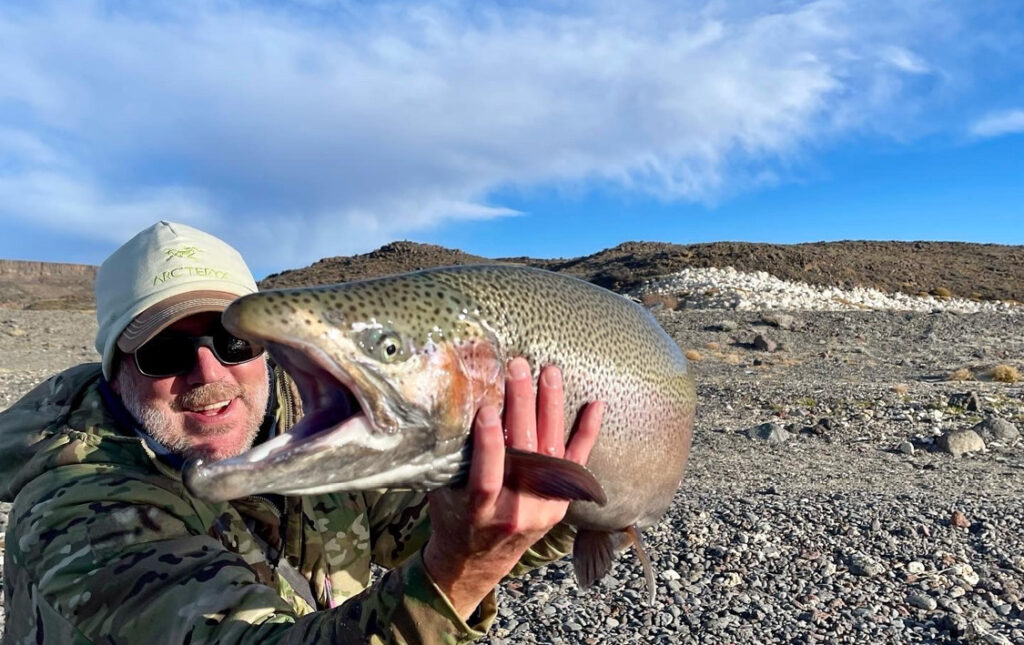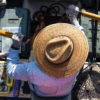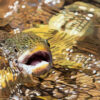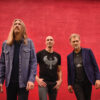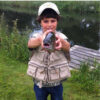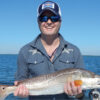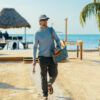A Trip of a Lifetime at the “End of the World”
Story by Joe Shields | Photos by Emiliano Luro
Everything is giant at the “End of the World” in Southern Argentine Patagonia, including the table where we took our meals, downed spirits and bantered. It was well suited for Vikings and perfect for the fly-fishing lodge that was home for May’s first week of winter.
Justin Witt, owner of global fly-fishing outfitter Hemispheres Unlimited, invited me and our friend Chris Young to experience his Trout Bum Jurassic program on a remote estancia in the southern Santa Cruz province. Based in Trevelin, a town founded by Welsh immigrants in Chubut province, the company offers a backdoor entry through its “Bum” programs into the world’s best fisheries at reasonable price points—without the glitz.
The itinerary for our 6,000-mile journey to an isolated lake was formidable by air and land with an overnight stay in Buenos Aires:
Washington Dulles International Miami International Ezeiza International El Calafate International minibus ground transfer along Ruta 40 (four hours) and 4×4 offroad excursion
(three hours) to the lake—Lago Strobel
Young and I embraced our 24-hour layover in the “Paris of South America” after checking into the Meliá Recoleta Plaza. The gaze of Evita Perón greeted us in the lobby where her portrait commemorates Perón living in the hotel from 1942 to 1944. Following lunch at Confiserié Monet, we visited Perón’s crypt at the Cemetario de la Recoleta.
After lunch, we went to La Boca to see the Boca Juniors soccer stadium where Diego Maradona played. We bought national team jerseys in the Caminito pedestrian mall and absorbed local art. People tangoed in the streets. We drank Quilmes near the house on Garibaldi Street where the Israeli Mossad captured Holocaust organizer Adolph Eichmann. We ended our day with remarkable, locally sourced seafood (rare in B.A.) and wines at ROUX on Peña.
In the morning, we flew to El Calafate, near the western boundary of the Southern Patagonian Ice Field and its glaciers, where we rendezvoused with Trout Bum Jurassic’s other visiting anglers for the seven-hour ground transfer. Like me, Nebraskan Ryan Sparks, editor-in-chief of Strung magazine, was on assignment. We met anglers from Georgia and Maryland, plus a handful from Maine.
We headed north along Argentina’s legendary Ruta 40, the country’s longest road. It begins in Cabo Vírgenes, the southernmost point of the Argentine mainland, and meanders north to Ciénaga, on the Bolivian border. Think U.S. Route 66 but bigger, like everything in Patagonia.
The minibus rambled through the Andean foothills along the western edge of the Patagonian steppe. Hundreds of llama-like guanacos darted across hillsides. Some jumped wire fences. Skeletons of the ones that didn’t clear the barbed road barriers hung like laundry on a clothesline, apocalyptic reminders of the frailty of life in a windswept land.
We stopped at Hotel La Leona’s café and museum to stretch our legs and relish Quilmes and empanadas. Situated at the convergence of the La Leona River, pampas (grasslands) and the Andes, the inn served as a base for expeditions to Mount Fitz Roy and a refuge for American outlaws Butch Cassidy and the Sundance Kid. Their wanted poster still hangs on the wall.
Back on the road, we witnessed an Andean condor feast on a guanaco carcass. With a wingspan reaching 10 feet, it is the largest flying bird in the world. We could see Fitz Roy in the distance; I noticed a stylized replica branded on some of our clothing.
Two hours later, we met Witt and professional photographer and guide Emiliano Luro, as well as guides Miguel Fontana, Julián Escalada, Luciano Arata and Albert Zwetzig to switch vehicles and begin our offroad journey in four Toyota Hilux 4×4 pickup trucks, which for some unfair reason are unavailable in the States. We rode in the dark through the middle of nowhere. After two hours, Fontana, driving the lead truck, swerved into the brush.
“He spotted a puma,” Witt said, following Fontana. “Miguel always spots them—and it’s rare to see one in the wild.”
Our lights reflected off the giant wildcat’s eyes. The puma faced our vehicles, then slowly walked away in the opposite direction. We finally arrived at the lodge an hour later.
***
South African Llewellyn Claven manages the lodge and oriented us on the environment, fishing, weather and safety upon our arrival. The big takeaway: if something bad happens, you’re dead. It’s that remote. The nearest hospital is eight hours away. He also managed to create one hell of a spread paired with Argentine wines, from Syrah and Tempranillo to Malbec.
“Tomorrow you will catch the biggest trout of your lives—and a ton of fish,” Witt told us during our late dinner. “On Day Two, you’ll experiment because it won’t be about the numbers anymore. Try dries, mouse flies and have fun. Six days is a lot of fishing here. If you need a break, I’ll take you to see petroglyphs.”
After breakfast, Young and I walked down a trail to Lago Strobel, which is 3,000 feet above sea level. The lodge is located near the mouth of the Rio Barrancoso, the lake’s only tributary, a food-rich river on a protected bay. The shoreline has several wind-sheltered, productive bays and coves, and anglers take turns fishing different beats.
On the strand, we discovered the Mainers were standing in the waves with bent rods. We chose an adjacent beat near the mouth of the river, and Young caught a giant rainbow on his second cast. Then he caught more.
Lago Strobel’s turquoise water is filled with huge numbers of rainbows that feed on scuds (freshwater shrimp) and aquatic insects. The Barrancoso has a very limited stretch of spawning water, which is why the trout are so big and the population never grows or shrinks.
Wind ripped across the water and waves crashed into men and rocks. We put on gloves, raised hoods, and fished Woolly Buggers on 7-weight rods. I double-hauled and quickly retrieved but didn’t catch a fish. Casting practice in high wind, but I marveled at the scenery.
Fontana, the guide on our beat, instructed me to strip more slowly. The micro-adjustment had a big impact, resulting in a soft take. I didn’t realize I hooked a fish at first, then my reel sizzled. The fight lasted five minutes. Fontana netted my first 30-inch rainbow. High-five.
A trout jumped high above the water; another torpedoed towards me in the crest of a wave. Distracted, I didn’t notice I had a fish on. A similar fight ensued, but Fontana was preoccupied netting Young’s fish. I waited for him and kept my rainbow close to shore. I looked down the beach and eight other rods were bent.
“Fun fish, eh?” said Fontana. I grabbed the fish from the net and held it over the water for a picture. “Thirty-two inches I think.”
Collectively, our success continued all morning. It began to snow.
“A double,” cried Young, as we reeled in two at the same time. Fontana netted both.
I observed the beat next to us and two other anglers scored a double. We lost count before lunch, which resembled dinner—grilled short ribs and rice, Argentine wines—followed by a siesta. Then we were back at it by 2 p.m.
Trout Bum Jurassic is a “bum” program minus the pizazz, but Claven and his team prepared incredible meals. Grilled chicken and yams, rib eye and potatoes, omelets and French toast—even “pizza night” was something else. The wines were delicious, especially the malbecs: El Psicoanalista; Fond de Cave; Fábula. Paired with hilarious stories at the giant table. We listened to the Mainers, real men, whose tales involved hunting dogs, moose calls, ice baths and canoes. Someone mentioned gauchos and violence.
“You don’t want to get into a knife fight with a gaucho,” Witt warned. “If a gaucho wants to kill you, he’ll thrust the knife between these two ribs in your breast plate and into your heart. If he wants to teach you a lesson, he’ll slash the tendons behind your knee and hobble you.”
Later that night, after gazing at stars that made you feel like you were closer to outer space and wishing I had procured a gaucho knife in B.A., I dreamed of giant trout. In the morning, I caught my first one on a mouse fly. Escalada measured it at 34 inches.
Claven joined us for a bit, long enough to cast a dry fly using one arm about 100 feet, sending his entire line into the channel. He reeled in a beast, then returned to the lodge.
The river froze, but I could still see fish spawn through cracks in the ice. I scanned the rocky coastline of the lake and the low barren mountains on the distant shore. Wind drove waves and fish leapt in the frigid air. I walked back to the beach, waded in and cast.
***
I’ve read the name Patagonia may have originated from the Spanish “patagones” (land of the bigfoot), and that Ferdinand Magellan and his men claimed to have seen giants on its shores. “Cities of gold” are also part of Magellan’s account.
Giants exist in Patagonia and so do treasures. I know bums who appreciate them.
For more information on Trout Bum Jurassic and other Bum programs, visit hemispheresunlimited.com.
Joe Shields is the editor in chief of The Virginia Sportsman. He is a writer and communications executive based in Charlottesville, Virginia. His writing and photography have appeared in The Virginia Sportsman and other publications. He is also an award-winning, gallery-represented artist whose work is found in private collections and galleries. Whether fly fishing or surfing, drawing or painting, he celebrates sporting life and culture in his narratives and art.

